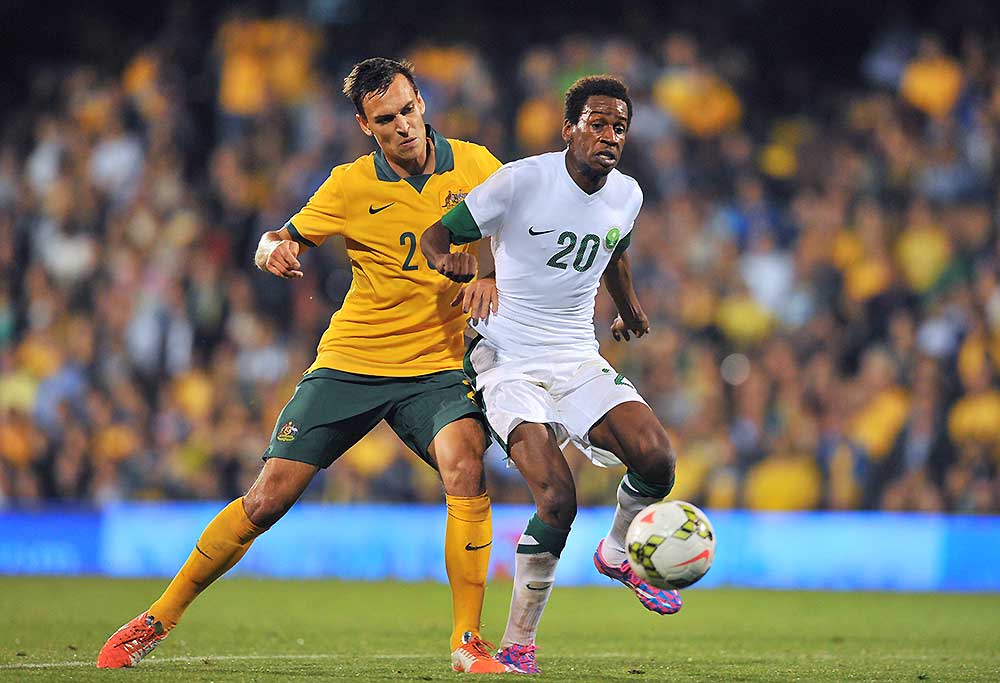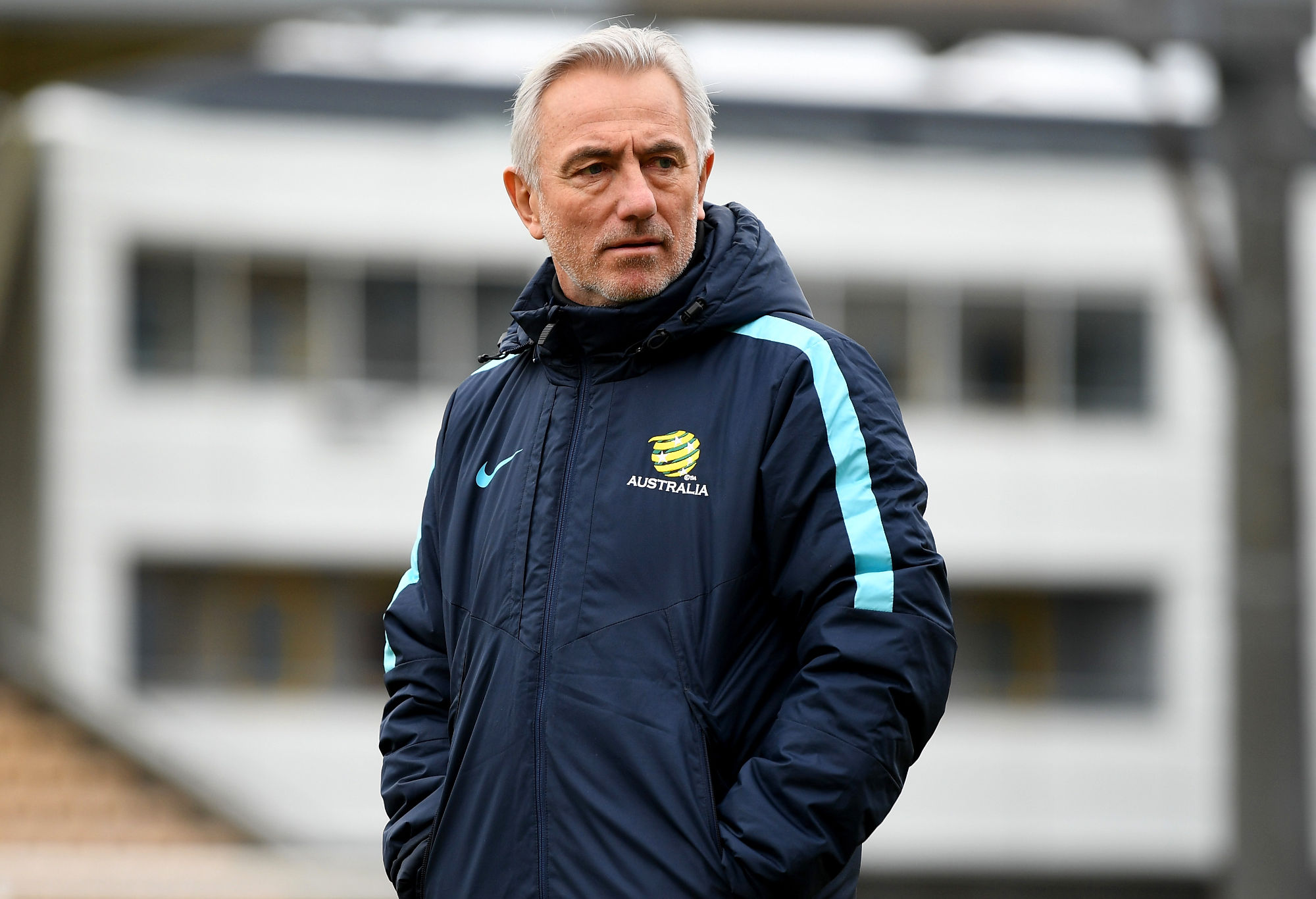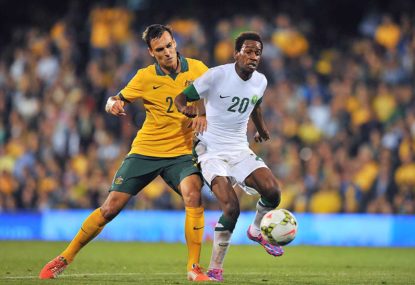In Italy, deep lying playmakers are called they are called the regista (director). In Brazil – where playmakers are more likely in the forward third – they are the meia-armador. In Australia, we call this player Trent Sainsbury.
As we approach Russia 2018, more and more pundits are calling Tom Rogic or Aaron Mooy our key player.
In a team game, this can trivialise a team’s tactics, but even though the key player may be more of a media idiom, in World Cup commentary this player has a unique quality and mythology.
They can be heroic agents single-handedly dragging their teams up the podium – like Diego Maradona in ‘86. But media darlings can also falter, fail or relegate their team to obscurity – like Diego Maradona in 1994.
By the nature of national teams being a random assortment of players born within a decade of each other on the same patch of dirt, there is often quite a variation in playing ability in a starting XI.
There are many examples of standout individual players in weaker teams: El Hadji Diouf for Senegal in 2002 and Mustapha Hadji for Morocco in 1998 jump out as dangerous playmakers pushing their team to a competitive standard (or beyond). Even in excellent teams with excellent players, it is common to find real stars stand out as playmakers – James Rodriguez announced himself in 2014 in an excellent side, earning a move to Real Madrid in the process.

James Rodriguez (AFP PHOTO/ DANI POZO).
But not all World Cup heroic playmakers of lore play upfront. Franz Beckenbauer, the ‘Kaiser’, in three World Cups lead West Germany’s attacking thrusts as the Libero – a sweeper/centreback who had the air cover to step out to aid the transition and then push into the final third.
The second coming of the Libero in German colours was Lothar Matthaus, who held the cup aloft in 1990, 16 years after the Kaiser. Other men like Gerd Muller and Jurgen Klinsmann might have knocked in the goals, but they were fed balls from the Libero who created attacks as verily as they repelled them in defence.
This brings us Trent Sainsbury. Sainsbury is the Socceroos’ key player and an essential playmaker for us in Russia – perhaps more than fans will ever realise. This is not only just because he is a central defender and will be needed to repel wave after wave of Antoine Griezmann and Christian Eriksen attack, but because the positional interplay between Sainsbury and Mile Jedinak will be crucial to unlocking French, Danish and Peruvian defenders, especially on the counter.

Trent Sainsbury (AFP PHOTO/GLYN KIRK)
Firstly, it seems inevitable that both Jedinak and Sainsbury will be in our starting XIs. Bert Van Marwijk may have shown his cards on the Mark Milligan experiment (though he didn’t have Sainsbury or Jurman in camp in March), so it seems likely that Sainsbury will be paired with either Milligan or Jurman, while Mile will form a midfield pivot probably with Aaron Mooy.
Mooy seems the choice here, principally because he plays this role for Huddersfield. Beside Jonathan Hogg (a pure defender), Mooy is Huddersfield’s deep sitting playmaker, who brilliantly set-up the goal that saved them from relegation against Chelsea with a perfectly weighted long ball that landed on a 10p coin.
BvM will be hooked on Mooy’s passing range (especially these long balls), and between Sainsbury and Mooy, (and Jedinak on a good day), he has a number of centrally placed players in the back block who can spring an attack. Socceroo plan A is for Luongo to also play, but a little further forward to use his run and energy in transition, especially collecting second balls.

Aaron Mooy (Photo by Christopher Lee/Getty Images)
Against France expect the Socceroos to line up in something closer to a 5-4-1 in defence, especially if Olivier Giroud starts (which Deschamps seems to favour). This will drive Craig Foster crazy as they may start with a formation analogous to the infamous 2010 game against Germany.
The thinking wasn’t ‘wrong’ per se by Verbeek in that game – but conceding goals very early killed the effectiveness of that game plan and we didn’t recover. Against France, BwM will look to get Jedinak as close to the line as possible to nullify Giroud’s aerial threat (arguably our ageing Jedinak’s last remaining elite ability).
This then provides Sainsbury or Milligan/Jurman – none of whom are particularly tall – to be able to step out and press Griezmann or Mbappe or Lemar when they gain possession between the lines. In the 5-4-1 formation the block could be extremely low, and he could look to place Mooy and Luongo in a compressed line ahead of the five.
This means we will effectively be looking to release two or three players on the break, ideally as high up the park as possible and ideally to (or near) Rogic (our Enganche) to bring speedsters Luongo and Leckie quickly into the attack. To succeed this requires perfectly weighted balls from Mooy and the brilliant passer Sainsbury.
In essence, for this plan to work we will need Sainsbury stepping-up in transition, effectively rotating with Jedinak, to spring forward transitions. In other words a Libero, with the air cover needed to sneak under French radars.
In the Denmark game BvM may be tempted to bring Milligan into central midfield to replace Jedinak, in a very deep lying or man marking role on Eriksen. On the very small amount of data we have on Bert Van Marwijk in green and gold he is not afraid to anchor a midfielder very deep and generally prefers experience over youth.
Jedinak is not the man to mark Eriksen, which leaves BvM with few options other than use Milligan or zonal mark the space between the lines with both players in the double pivot – which sacrifices another player from the transition.
If Van Marwijk takes this path then Sainsbury becomes even more essential, as the progenitor of transitions, and a short pass option if Milligan or our other central defender can win one-on-ones.
For Peru where points (or a final hurrah) are needed, BvM will need to switch to plan A. Here he should look for other, more creative ways to utilise Sainsbury’s passing skills. In the plan A we must see Mooy and Luongo further forward, and without a hulking forward threat to sweat on, Sainsbury should be encouraged to step out and join the passing chains, with cover again from Jedinak.
In truth, as his home club in Grasshopper have established, Sainsbury’s biggest impact on a game can be in central midfield – a movement one hopes BvM has taken notice of. As Jedinak has grown with age into a central defender who can step into midfield, a complete shuffle of Mile and Trent seems the most logical option to this writer to give the Socceroos the best chance to transition from defence with more accurate passing, while also enabling the man-marking option.
Mark Milligan has been an excellent workhorse for the Socceroos, but he is not as clean on the ball as Trent Sainsbury. Placing Sainsbury in Eriksen’s space, with Jedinak in the back four represents the perfect mix of muscle, grit and guile.

Bert van Marwijk has (Photo by Michael Regan/Getty Images)
The data speaks for itself in the head-to-head comparison between Sainsbury and Jedinak and points to their respective role changes. As ball players, Sainsbury is completing 50 passes a game at 76 per cent accuracy compared to Jedinak’s 31 at 74 per cent – with Sainsbury specifically impressing with long balls.
In the defensive phase Sainsbury is also disrupting more forward play than Jedinak – a byproduct of playing as a regista. Sainsbury is completing 2.8 tackles per game compared to 1.5 for Jedinak, while he is also completing more interceptions per game at 1.8 versus 1.2. On the flipside Jedinak is leading Sainsbury in clearances with (a whopping) 4.5 versus 2.3 which highlights Jedinak’s tactical move to the defensive line. The reversal in roles is marked in these stats.
The key insight from these stats is that Sainsbury’s passing this season has by far exceeded anything produced by Jedinak in his career in England – both in terms of passing success and aggregate passes. At Grasshopper Sainsbury is a playmaker whose excellent, albeit muscular (4 yellows in nine games) defensive work solidifies the defensive structure.
Where the Enganche sits at the top of midfield, the Socceroo ‘hook’ will be deeper lying, and Sainsbury is that man while the opposition’s eyes will be on Aaron Mooy. Sainsbury has been a revelation in the National team since forcing his way into the 2015 Asian cup team, and will likely be in the starting ballot to eventually replace Jedinak as captain.
And, as a playmaker, he is just-just-under the radar enough in Russia to take opposition forwards, mids and managers by surprise.

































































































